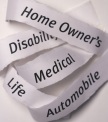The foundation of a successful financial plan lies in ensuring that risks  are eliminated,mitigated or transferred. Insurance can fulfill one or more of the above functions. Insurance can broadly be divided as Life insurance and Non-Life insurance. We saw that the first step in achieving financial freedom is buying a Term Insurance. The next step is to ensure we have adequate non-life insurance (Don’t grow impatient. I promise we will discuss things like ‘growing money’ soon).
are eliminated,mitigated or transferred. Insurance can fulfill one or more of the above functions. Insurance can broadly be divided as Life insurance and Non-Life insurance. We saw that the first step in achieving financial freedom is buying a Term Insurance. The next step is to ensure we have adequate non-life insurance (Don’t grow impatient. I promise we will discuss things like ‘growing money’ soon).
Health Insurance Plan (HIP/Mediclaim):
- Health insurance protects the policy holder and his/ her
 family against any financial contingency arising due to a medical emergency. This policy provides for reimbursement/cashless treatment of hospitalization/domiciliary treatment expenses for illness/disease or accidental injury. 3rd party administrators (called TPA) administer the policy.
family against any financial contingency arising due to a medical emergency. This policy provides for reimbursement/cashless treatment of hospitalization/domiciliary treatment expenses for illness/disease or accidental injury. 3rd party administrators (called TPA) administer the policy. - Medical expenses incurred during period of 30 days prior to and period of 60 days after hospitalization are covered. Any one illness will be deemed to mean continuous period of illness and it includes relapse within 45 days from day of discharge from the hospital.
- Normal exclusions include all diseases/injuries which are pre-existing at the time of taking the cover. Most policies now cover pre-existing diseases as well after a specified period of time (usually 4 years).

- HIP may have various limits and sub-limits for every aspect of hospitalization. For example: Insurer may say that room rent per day shall not exceed 1% of total coverage. So if your coverage is 5 Lacs room rent per day up to Rs. 5000 shall be reimbursed.
- HIP may have co-pay. For example: The first 20% of the bill is paid by the insured and the rest is reimbursed by the insurer. This will reduce frivolous claims and keep overall costs lower for the population.
 HIP is now portable. So you can move to another insurer with certain entitlements earned with the previous insurer. Assume you have taken a HIP today and paid some premiums (say for 3 years until 2014) and you decide to port this policy to another company with similar coverage. With the new company you don’t have to wait for 4 years afresh to start covering pre-existing illnesses (as in the past). Your pre-existing illnesses will now be covered after 2015 itself. This is a great relief as many companies typically increased insurance premiums even when no claim was made. Since people wanted to ensure preexisting illnesses were covered they had no choice but to stick around with the previous insurer. A right step that IRDA has taken and something we as consumers must know.
HIP is now portable. So you can move to another insurer with certain entitlements earned with the previous insurer. Assume you have taken a HIP today and paid some premiums (say for 3 years until 2014) and you decide to port this policy to another company with similar coverage. With the new company you don’t have to wait for 4 years afresh to start covering pre-existing illnesses (as in the past). Your pre-existing illnesses will now be covered after 2015 itself. This is a great relief as many companies typically increased insurance premiums even when no claim was made. Since people wanted to ensure preexisting illnesses were covered they had no choice but to stick around with the previous insurer. A right step that IRDA has taken and something we as consumers must know.- Employer provided Health insurance is good but not sufficient, how much ever that plan covers. One should have their own HIP. Multiple reasons: Employer reducing benefits as part of cost cutting, Change of employers, Loss of job, being in-between jobs, taking a break in job to pursue higher education (say, a MBA), taking a sabbatical etc. Trying to buy a health plan when any of the above happen is not a prudent idea and may expose the individual.
- Family floater is a great cost saver but is risky. Assume a family of Husband, wife (Both in early 30s) and their kids taking a family floater
 insurance with the husband as the proposer. Assuming the proposer passes away some 30 years later. At this point the policy cannot be renewed any further. If the wife now intends to take a fresh cover it is going to cost a fortune regardless of the fact she was covered for 30 years and even if she has had no major ailment in that duration. Hence I would recommend each spouse take an individual health plan for themselves and when they have kids convert one of those plans into a floater policy only covering themselves and the kids. The other spouse must remain with the individual plan. When kids become majors they will need to have their own HIP.
insurance with the husband as the proposer. Assuming the proposer passes away some 30 years later. At this point the policy cannot be renewed any further. If the wife now intends to take a fresh cover it is going to cost a fortune regardless of the fact she was covered for 30 years and even if she has had no major ailment in that duration. Hence I would recommend each spouse take an individual health plan for themselves and when they have kids convert one of those plans into a floater policy only covering themselves and the kids. The other spouse must remain with the individual plan. When kids become majors they will need to have their own HIP. - Ensure you provide honest details about your health when taking health insurance. Insist on a medical test (most companies anyway do) so you claim has lesser chance of being rejected in future because the insurance company is supposed to have done a full evaluation of the health status (that DOES NOT preclude you from providing information in full) – this just gives you an upper hand case in case of a conflict.
 Tell everyone in the family where the Medical insurance cards are. I would recommend everyone has a copy of the card with them. Also make a note of the list of hospitals in your area covered by your plan.
Tell everyone in the family where the Medical insurance cards are. I would recommend everyone has a copy of the card with them. Also make a note of the list of hospitals in your area covered by your plan.- Claims must usually be filed within 45 days of hospitalization [Even for employer covered plans]. Ensure you are not lazy and do the paperwork in time.
- Go for Health insurance plans where the settlement rate is higher. Chances are your claim will also be settled. Also choose HIP that lets you renew at least until you are 80 years old or more.
Critical illness insurance
This policy provides for a lump sum benefit to be paid if the named insured contracts certain specified diseases such as Stroke, Heart attack, cancer etc. There is no payment on death. Payment is usually subject to a minimum survival period of 30 days after the diagnosis. With the current lifestyle it is imperative that one takes critical illness insurance. This will ensure that any loss of income associated with the illnesses can be mitigated.
Personal Accident Insurance policy (PAIP):
This policy offers compensation in case of death or bodily injury to the insured person, directly and solely as a result of an accident, by external, visible and violent means. Although usually sold as riders with Term plans, PAIP can also be purchased separately.
Motor Insurance:
Motor insurance covers: A) Destruction to motor vehicle of the insured and the motor vehicle of the counterparty in an accident and B) Other damages caused to the counterparty (bodily injury/death etc.). In India the insurance of one’s own motor vehicles against damage is not compulsory but the insurance of third party liability arising out of the use of motor vehicles in public places is. Thus having a motor insurance is mandatory to drive a motor vehicle.
-
Maintain your vehicle in top shape so accidents due to vehicle mal-function can be reduced greatly
Property Insurance:
 The insurance covers one’s property against mishaps like natural disasters, societal vandalism and terrorist attacks. One must insure their properties, starting with their primary residence. Land need not be insured as it is indestructible. The buildings on them, however, are susceptible and need to be insured in line with market value.
The insurance covers one’s property against mishaps like natural disasters, societal vandalism and terrorist attacks. One must insure their properties, starting with their primary residence. Land need not be insured as it is indestructible. The buildings on them, however, are susceptible and need to be insured in line with market value.
If you live in a seismic zone or closer to the coast it is better to take property insurance. Small business owners definitely need to insure their establishments and godowns. No point scrimping money here.
Keyman Insurance:
A keyman, as the word suggests is the ‘key man’ in a business context – say a CEO or a sales executive of a firm. A company can take ‘Keyman insurance’ so should something untoward happen to the key person the company will be compensated monetarily for the potential loss of business caused by the absence of the keyman.
While this appears on the outside to be suitable for large organizations this is more so applicable for small firms run by a handful of people, really. A large firm can find near suitable replacement in the market for a higher cost if need be. Small businesses and family businesses will benefit by the keyman insurance. Obviously a detailed cost benefit assessment needs to be done in taking this insurance.
Income Protection Insurance:
Income protection insurance ensures that one has an income stream to rely on in case of short-term or long-term inability to work. Income protection is designed specifically to cover one in the event of a significant loss of earnings caused by illness or injury. However, some short-term policies also build in cover for unemployment or redundancy. The cover is usually for a few months from the time an unfortunate event has occurred. Generally such plans are a no-no regardless of how sweet talked we are about the benefits . A PAIP (Personal Accident Insurance policy) and an emergency fund that will allow one to subsist for at least 6 months, part of sound financial planning, should be your immediate reach when such an event occurs.
A closing note: “Discussing insurance in itself is not very  interesting”- I have had this feedback several times. Déjà vu. However, Insurance forms the basis of financial planning. In the context of a home: Insurance is akin to the safety measures taken for a home – like adding dead bolts to the door, a second iron grill door etc. Home decoration and luxury amenities can be compared to growing money by investing. Safety of the home is of paramount importance than the amenities, I am sure all you will all agree.
interesting”- I have had this feedback several times. Déjà vu. However, Insurance forms the basis of financial planning. In the context of a home: Insurance is akin to the safety measures taken for a home – like adding dead bolts to the door, a second iron grill door etc. Home decoration and luxury amenities can be compared to growing money by investing. Safety of the home is of paramount importance than the amenities, I am sure all you will all agree.
What we have done so far is ‘justsavemymoney’. We will next move on to topics where each one can ‘justgrowmymoney’.


Dear Sir – You had advised on taking additional heath insurance in addition to what is provided by current employer and while searching I came across”
“PNB-ORIENTAL ROYAL MEDICLAIM INSURANCE POLICY (WITH FAMILY FLOATER) FOR PUNJAB NATIONAL BANK ACCOUNT HOLDERS / EMPLOYEES” and its looks very attractive to me as I am a PNB a/c holder and the premium rates are very reasonable as compared to others.
Can you kindly go through the below link and suggest that there are no loopholes in this policy and I can go for it?
http://www.pnbindia.in/En/Ui/content.aspx?Id=245
Thanks & Regards,
Anurag
Anurag – Bank provided insurances are group insurances and are relatively inexpensive because the risk is spread among a larger set of people.
The plus point is that it covers family members beyond 65 years as well (in most cases upto 80 years) provided they are enrolled before the age of 65. However there is usually a copay of 20% for the elderly which I think is fine.
You have to make sure there are a number of network hospitals available in your vicinity so you can get cashless treatment out of this – these plans as such are clean and straight forward but you should do your due diligence on aspects like the one I mentioned above.
Thank you Anand ji. This is very helpful. I will then go with this policy.
Regards,
Anurag